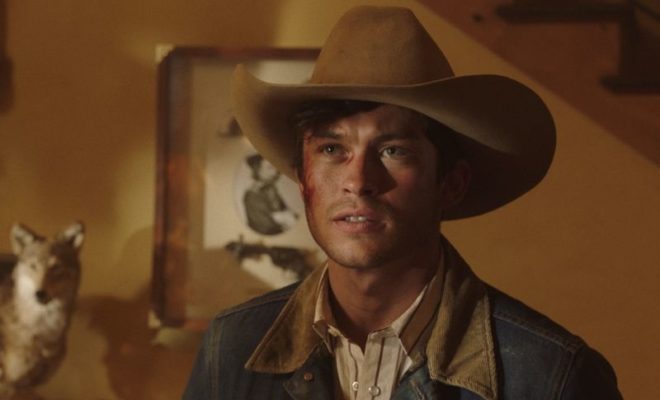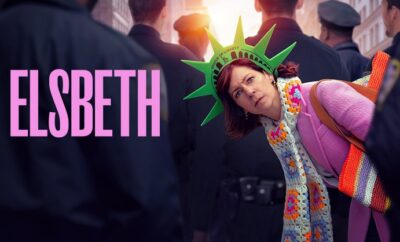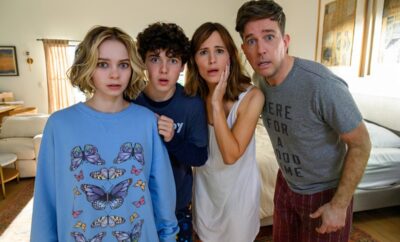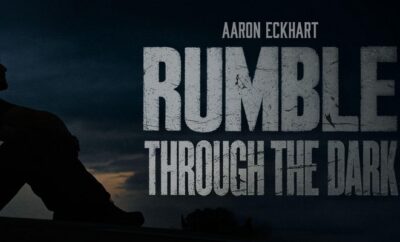
Interviews
Graham Phillips – The Bygone
By: Jamie Steinberg
Q) What are the recent projects that you are working on?
A) As you know, directing and writing and starring in a film takes a lot of time. So, for the last two or three years we’ve been making The Bygone. So, that’s taken up a lot of our time. But we have our next feature that we’re working on called Rumble Through the Dark, based on a novel called The Fighter by Michael Farris Smith. If you’re looking for a really good book to read, this one is really great. It’s a quick read and it’s my favorite genre of Southern gothic noir sort of thriller. The characters are so good. We’ve been working on that and getting that into development. We’re looking to shoot that in April. I’m going back to the show “Riverdale” for a couple of episodes and there is this film called Yes Day with Jennifer Garner that I have a funny cameo in that I’m working on next month.
Q) Where did concept for The Bygone originate?
A) Well, I was a US History major and my thesis actually focused on certain Native American issues, particularly native resistance to colonialism. But it also had a lot to do with violence against native women in the historical context and how they have battled it over the centuries. My brother had sent me an article showing that violence towards native women was exacerbated by the oil boom in North Dakota. A lot of trafficking went on in North Dakota for a number of reasons, but predominantly that there is just this large influx of all male workers going to these remote areas that creates a market for the sex trade and also the lack of law enforcement in those remote areas contributes to the issue as well. Then, you also have the issue compounded by the fact that native women are the most victimized demographic in the United States. So, it all comes together to create this perfect storm of sorts and it really resonated with me and my brother because not only is it an issue we knew nothing about and on many levels it is horrifying, but it felt like an echo of the past in terms of what happened in the gold rush. Pretty much the same circumstances happened a hundred – a hundred and fifty years ago. So, at the same time, we were trying to figure out what our next film was going to be. We wanted to do a Western. We wanted to do a missing person’s story. Then, when we heard about this, it seemed like a great way to tie in the Old West with the new, to try to give light to an issue that is actually impacting Americans. Also, it had a bit of a theme we wanted to explore of what is the place of the Old West in modern times and how far have we really progressed as a nation if we are still dealing with the same stuff that we were two hundred plus years ago.
Q) What was something that surprised you that came up during the making of this movie?
A) Yeah, there were a lot of challenges. First of all, just getting a movie financed is near impossible. So, that was a challenge in the sense that we wanted to film in beautiful North Dakota because it has the historical look about the lands. When you see The Badlands and these areas where these famous battles took place up by Roosevelt National Park it seems so amazing. But you can’t film there. There is not a crew. It’s in the middle of nowhere. There is no tax incentive. So, we ended up filming in Oklahoma. Then, the challenge was shooting Oklahoma to look like North Dakota. What we ended up doing is we got clever with our effects and we went to North Dakota and filmed a lot of the background that we plugged into the film – a lot of drone shots and driving shots – that kind of add the flavor of North Dakota without breaking the bank.
Q) Were you always interested in starring it as well as co-directing it?
A) I am more drawn to just directing or just acting. I hadn’t had a really great role that resonated with me in a while and it was kind of more my brother’s idea to write a role that would be good for me to play. At times it was a little overwhelming, but I’m always someone who tends to thrive when I put too much on plate. If I have one job then I find that sometimes more difficult than tackling three jobs at once because I go into work mode a little more. So, it ended up working out, but we definitely didn’t set out a role to write for me. It just sort of happened organically, I guess.
Q) How involved were you in the casting of the film?
A) My brother (Parker Phillips) and I were both very involved with the casting. We were pretty aware of the fact that casting is arguable the most important aspect of the film after the script. If you don’t have actors that you invest yourself in then the whole thing falls apart from the very beginning. We basically cast people that we knew in one way or another through mutual friends. We were keeping the budget very low so we weren’t paying anyone what they are normally used to so we had to make sure that the script really resonated with them. It was really neat because a lot of times an actor will take a role just because it pays well, but there was not a lot of pay. You know when someone is taking a pay cut and they want to do a role just because the role speaks to them. So, that was really nice to have such dedicated people. We looked in the theater community as well for people with strong theater backgrounds. That’s how we ended up with Ritchie Coster who is playing Uncle Beckett. We wanted an actor that could really chew on his words and he certainly didn’t disappoint.
Q) When it comes to cinematography with this film, how does the setting of North Dakota play almost a role itself in this movie?
A) One of the central themes of the film is the encroachment of modernity and industry on The Old West. In order for us to really hammer that home we wanted to show people that juxtaposition of that iconic Western landscape that you sort of just imagine will always be there unadulterated, which North Dakota has so much of. Juxtaposing that with the flaring towers and oil rigs and the pump jacks that have begun to litter the landscape, we wanted people to think (as the characters are driving around and you’re seeing all this in the background) like, “Man, what a beautiful landscape this would be if it wasn’t for the fact that the horizon is on fire.” [chuckles] It really helped to show this idea that we may be pushing a little too far as far as trying to dominate our land and conquer this land and extract as much as we can from it with the set cinematography. We wanted to show it with the cinematography because it’s that same psychosis of conquering and extracting that Beckett represents. That represents that darkest part of our country’s history and the darkest parts of what we are still up to today.
Q) What was it like working so closely and co-directing with your brother Parker?
A) It was pretty easy. There were definitely times when us being brothers we can get away with certain arguments that if we were collaborators that weren’t family that we’d be able to get away with. [chuckles] Overall, we have a near identical vision and near identical stylistic sentiments. It was pretty peaceful. It was a pretty peaceful venture, thankfully. [laughs]
Q) What were some of your favorite scenes to film or memorable moments from filming?
A) I loved filming the action scenes. We had a really fun time filming the action sequence with the Sheriff (Michael McColl) and the pimp in the pipe yard. The problem was that there were forty mile per hour winds that day so you get the dust, grit and grime flying through the pipes, which actually were like a rocket of sorts shot at everyone’s faces. So, we had to go and get ski gear just to function. By the end of the day we looked like you’re filming Lawrence of Arabia, just completely covered up. It was just really challenging to get through it. You knew it was bad when our first AC came up to us and asked if we had wind insurance. I knew we didn’t have wind insurance. No one has wind insurance in Oklahoma because it’s always windy! [laughs] That was a challenge. I’d say the other big challenge, which is funny because the challenges are what I also sort of see as most fun as well, is the end of the film calls for an abandoned coal mine. There are really not many mines in Oklahoma. There are a couple lead mines, but it’s really unsafe to go in there and they really didn’t look that great. We found this state park, Alabaster Caverns, which was like four hours away from where we were shooting. It’s this massive underground cavern that we decided to put a bunch of wood in and then dress it to look like a gold mine. The problem was…Well, there were a few problems. [chuckles] But the biggest problem was that there were about nine thousand hibernating bats in this cavern. The one rule was don’t wake up the bats, but of course we have a shoot-out in the end in the gold mine. Let’s just say there were a lot of bats flying around by the time we finished shooting. [laughs] So, that was an interesting one.
Q) What did you enjoy most about making this movie?
A) One of the things that was the most fun about it was something that I knew a lot about and something that I knew nothing about. What I mean by that is my family came from the south in Oklahoma and I grew up riding horses and loving Westerns. I knew a bit about US History, but as we were writing it I was really diving into the American history. So, on the flip side, while we were doing research for the film and talking to folks of the native community, I was also learning how much I had yet to learn about Native American history and their culture and the beauty of it all. It was just a really exciting first project for us because I think that in a perfect world…Maybe not a good artist, but a satisfied artist makes sure that their projects speak to something that they know, but also allows them to grow. It was just really fun to get to hear from everyone about their different perspectives of what the film was about and just to get to tap into the oldest history that the US has and get to talk to a lot of interesting Native folks throughout the whole process. I’d say that was probably the most exciting thing for me.
Q) What do you hope viewers take away from watching The Bygone?
A) First and foremost, I just hope they are entertained by it. [chuckles] I hope that they learn a little something about our history. The Western has always been a genre that purports to explore American history and we wanted to do one that told it with a little more truth than some of the older Westerns do – turning some of the stereotypes on their head. Really, we wanted to hammer in to people that The Wild West isn’t dead and it’s still alive today if you know where to look.
Q) We loved you on “The Little Mermaid Live!” What made you want to be a part of this?
A) Well, I’d always wanted to be a mermaid but they weren’t ready for a merman. So, I had to settle for the prince, unfortunately. [joking] My eight-year-old niece Stella was very excited about that. [chuckles] I started out my career singing in opera and on Broadway and it had been like ten years since I’d sung professionally. So, I had re-caught the singing bug and I felt like this was a good opportunity for me to get into singing away in a very joyful production, one that seemed like it would be a lot of fun. And a lot of fun we had!
Q) What did it mean to you to portray an iconic Disney character?
A) It meant a lot to me to play Prince Eric, honestly, for a couple of reasons. One is because The Little Mermaid is the first film I remember watching. So, that was fun. Also, it was exciting because when you watch the original Prince Eric doesn’t really say that much and doesn’t stand for that much. You don’t really hear from him much in the sense that he doesn’t sing any songs. But in this version Alan Menken lifted some of the songs from the Broadway version and adapted them and so I had three numbers to get to introduce a lot of people to what is going on in Eric’s mind – why he’s falling in love with a mermaid and what he is looking for in life. He’s sort of showing that he’s a bit of a poet himself. That was really exciting.
Q) We really enjoyed you as Zach Florrick on “The Good Wife.” What did you personally take away from working on the series?
A) Well, “The Good Wife” filmed in New York and we got a lot of theatrically trained actors. So, I think I learned a lot about how just because you’re on TV and just because you’ve got a camera that is right in your face it doesn’t mean you can get away with playing less committal or playing safe. These actors like Alan Cummings and Christine Baranski, they don’t bring themselves down for the medium of TV. They still radiate that energy and make strong choices. I think that learning you can still be bold even with on camera work was an important lesson for me and one that I’m sort of working on now.
Q) What would you like to say to everyone who is a fan and supporter of you and the work you do?
A) I’d say to stick around because it is always going to be evolving and I hope that the day never comes when anyone who is following my career gets bored because boredom is something I never find myself getting close to. If I do, I hope my fans will call me out on it and I’ll fix it as quickly as possible. [laughs]





You must be logged in to post a comment Login